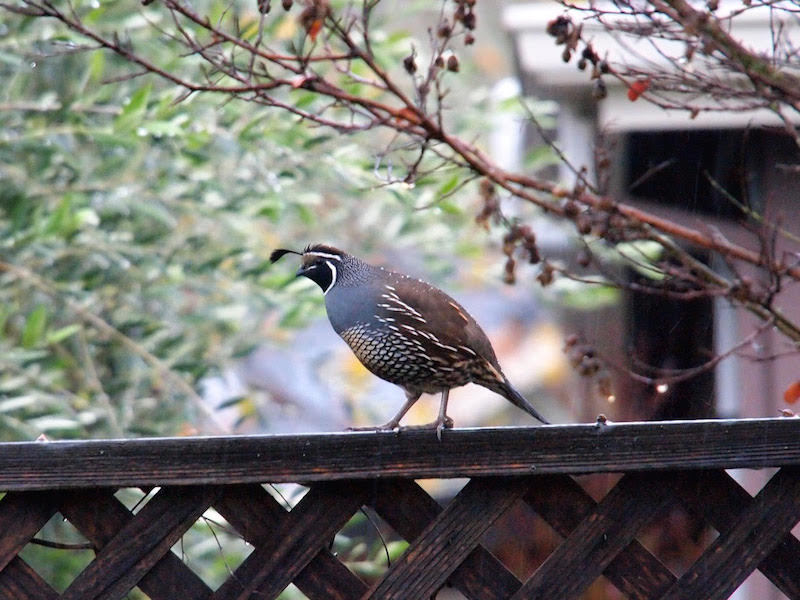Now is the time to prepare for this year’s fire season by pruning and trimming around your home with an eye to both fire-readiness and wildlife habitat. Yes, now, in the middle of winter, before March 1. By early March birds will be nesting and breeding in the vegetation and it’s best not to disturb them.
There are other good reasons to prune in the winter season: many plants are dormant at that time; and it’s cool out, so the work is more pleasant than in summer. But most important, birds such as quail, goldfinch, junco and others nest on the ground or in the shrubs and tall grasses. If you look closely, you’ll find towhee nests in low forks (3-12 feet high) in shrubs or small trees – live oak, Ceanothus, coffeeberry, even poison oak, and many ornamentals.
Here’s an excerpt about California quail nesting from Cornell Labs, a preeminent source of bird research: “Female California Quail typically hide their nests on the ground amid grasses or at the bases of shrubs or trees. The nest is usually a shallow depression lined with stems and grasses, and often placed near vegetation or rocks for protection. Nests range from 5-7 inches across and 1-2 inches deep.”
Let’s provide a welcome home for the quail, our state bird, by respectfully timing our fire-wise vegetation management. That means doing it before the beginning of March when nesting starts, remaining in full swing until the end of August.
Many government entities, including Sonoma County, require that homeowners maintain a “defensible space” within a radius of 100 feet around the home – though this does not mean removing all trees and vegetation in that space, but rather removing highly combustible materials, dead vegetation and ladder fuels. Pruning dead branches from trees and shrubs, increasing vertical spacing between shrubs and lower limbs of trees, and creating islands of shrubs with space between to interrupt the movement of fire, are key fire-wise strategies. (See sidebar for links to more information.)
Along with proper vegetation management, “home hardening” – for example, installing non-combustible roofs and decks, among other fire-resistant features – is considered the most effective thing you can do to protect your home from fire. In a fire-prone environment like ours, both steps are important – but for the sake of our local wildlife, good timing is key.
A team of local experts, including from Sonoma Ecology Center, Sonoma County UC Master Gardeners, and Habitat Corridor Project, has been working on the subject of fire-smart, water-wise and wildlife-friendly landscaping. Please watch for more information and workshops on the subject, coming soon!
This article was written by Ellie Insley, a landscape architect and board member of Sonoma Ecology Center.
LINKS
Most birds nest between March 1 and Aug. 31. Vegetation removal can be very disruptive during bird breeding season, so it’s best to get that job done beforehand. Note also that many birds are protected by the Federal Migratory Bird Treaty Act, making it illegal to damage or remove their nests.
See these links for more information on tree care, home hardening, and maintaining a defensible space around your home:
- Guidance on tree care and bird nesting: https://goldengateaudubon.org/conservation/make-the-city-safe-for-wildlife/tree-care-and-bird-safety/
- Guidance on home hardening: https://disastersafety.org/wildfire/protect-your-home-from-wildfire/
- Guidance on maintaining defensible space in Sonoma County: http://sonomacounty.ca.gov/PRMD/Fire-Prevention/ or https://www.sonomaecologycenter.org/wp-content/uploads/2018/10/2018Landowner-WaterFireWildlife-Pamphlet-Oct5.pdf
- Guidance on pruning: https://ucanr.edu/blogs/blogcore/postdetail.cfm?postnum=26190 or https://www.cnps.org/gardening/pruning-native-plants-4033

